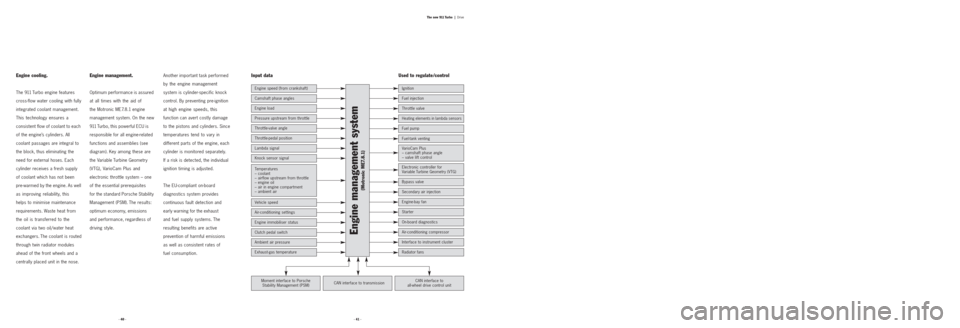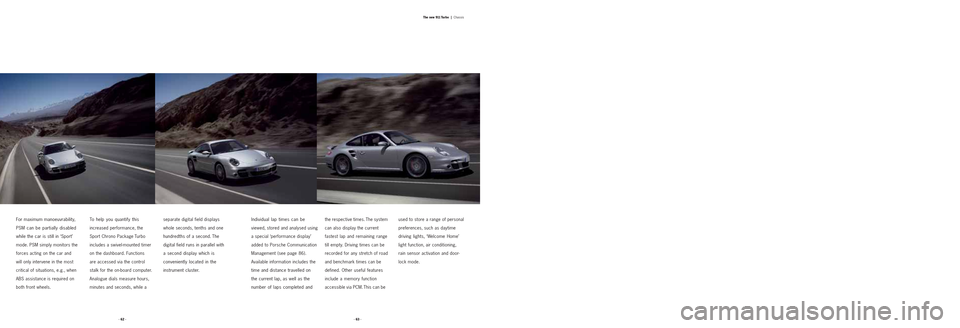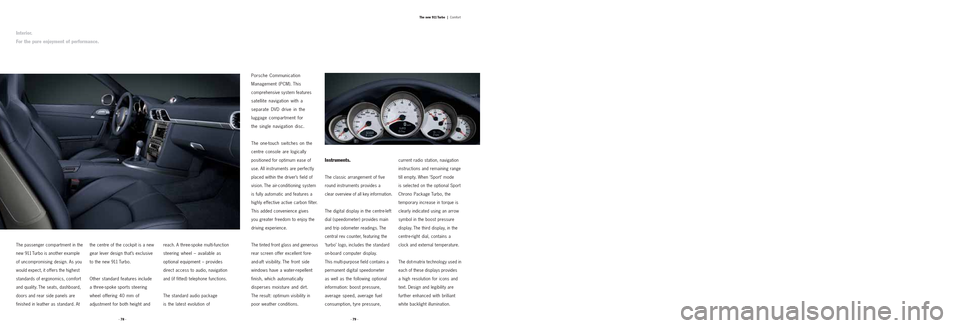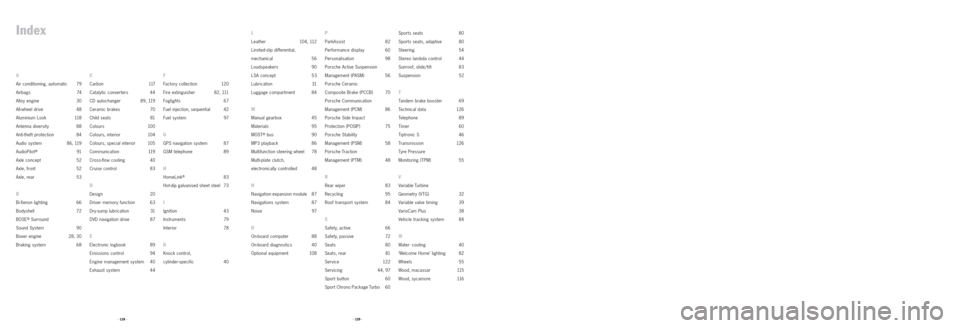air conditioning PORSCHE 911 TURBO 2004 4.G Information Manual
[x] Cancel search | Manufacturer: PORSCHE, Model Year: 2004, Model line: 911 TURBO, Model: PORSCHE 911 TURBO 2004 4.GPages: 61, PDF Size: 2.14 MB
Page 16 of 61

Engine cooling.
The 911 Turbo engine features
cross-flow water cooling with fully
integrated coolant management.
This technology ensures a
consistent flow of coolant to each
of the engine’s cylinders. All
coolant passages are integral to
the block, thus eliminating the
need for external hoses. Each
cylinder receives a fresh supply
of coolant which has not been
pre-warmed by the engine. As well
as improving reliability, this
helps to minimise maintenance
requirements. Waste heat from
the oil is transferred to the
coolant via two oil/water heat
exchangers. The coolant is routed
through twin radiator modules
ahead of the front wheels and a
centrally placed unit in the nose.
Engine management.
Optimum performance is assured
at all times with the aid of
the Motronic ME7.8.1 engine
management system. On the new
911 Turbo, this powerful ECU is
responsible for all engine-related
functions and assemblies (see
diagram). Key among these are
the Variable Turbine Geometry
(VTG), VarioCam Plus and
electronic throttle system – one
of the essential prerequisites
for the standard Porsche Stability
Management (PSM). The results:
optimum economy, emissions
and performance, regardless of
driving style.Another important task performed
by the engine management
system is cylinder-specific knock
control. By preventing pre-ignition
at high engine speeds, this
function can avert costly damage
to the pistons and cylinders. Since
temperatures tend to vary in
different parts of the engine, each
cylinder is monitored separately.
If a risk is detected, the individual
ignition timing is adjusted.
The EU-compliant on-board
diagnostics system provides
continuous fault detection and
early warning for the exhaust
and fuel supply systems. The
resulting benefits are active
prevention of harmful emissions
as well as consistent rates of
fuel consumption.
· 40 ·· 41 ·The new 911 Turbo |
Drive
Input data Used to regulate /control
Engine management system
(Motronic ME7.8.1)
Engine load
Pressure upstream from throttle
Throttle-valve angle
Engine speed (from crankshaft)
Camshaft phase angles
Throttle-pedal position
Lambda signal
Knock sensor signal
Ignition
Fuel injection
Throttle valve
Heating elements in lambda sensors
Fuel pump
Fuel-tank venting
CAN interface to
all-wheel drive control unit CAN interface to transmissionMoment interface to Porsche
Stability Management (PSM)
VarioCam Plus
– camshaft phase angle
– valve lift control
Electronic controller for
Variable Turbine Geometry (VTG)
Bypass valve
Secondary air injection
Engine-bay fan
Starter
On-board diagnostics
Air-conditioning compressor
Interface to instrument cluster
Radiator fans
Vehicle speed
Air-conditioning settings
Engine immobiliser status
Clutch pedal switch
Ambient air pressure
Temperatures
– coolant
– airflow upstream from throttle
– engine oil
– air in engine compartment
– ambient air
Exhaust-gas temperature
Page 18 of 61

are reduced thanks to lengthy
replacement intervals for both
the engine oil (18,000 miles) and
air filter unit (36,000 miles). The
spark plugs require changing after
36,000 miles or a maximum of
every four years. The generator,
power-steering pump and air-
conditioning compressor are all
driven by a single self-adjusting
belt with a service life of 54,000
miles. The hydraulic tappets
provide automatic adjustment of
all valve clearances, while the
drive chains on the camshafts
and auxiliary shafts will also last
the life of the car.
Basic servicing is required after
18,000 miles or a maximum of
two years on the road. The first
major service is due at 36,000
miles or every four years at the
latest. The results: lower running
costs and virtually uninterrupted
enjoyment from your Porsche.
Exhaust system.
The exhaust system on the
911 Turbo is made from highly
durable stainless steel. The
system consists of two separate
tracts, one for each bank of
cylinders. The catalytic converters
are extremely heat-resistant,
yet quick to reach temperature
(and thus optimum performance)
when the engine is started
from cold.Twin lambda sensors in each of
the exhausts enable continuous
monitoring of the combustion
process. An additional pair of
sensors* is used to measure
the efficiency of the catalytic
converters.
Servicing.
Another pleasant surprise on the
new 911 Turbo is the standard
service schedule. Running costs
The new six-speed manual
gearbox in the 911 Turbo is
specifically adapted to the car’s
high levels of engine torque.
Designed primarily for sports
driving, one immediate
characteristic is the perfectly
judged spread betweensuccessive ratios as you upshift
through the gears. The gearshift
throw is short and precise,
with only minimal force required.
Thanks to a dual-mass flywheel,
this uncompromising setup means
there’s never any compromise
in comfort. The linkage provides
a direct connection with the
gearbox while insulating
the lever from engine vibration.
One final detail – the new gear
lever design – is exclusive to
the 911 Turbo.
· 44 ·· 45 ·The new 911 Turbo |
Drive
Six-speed manual gearbox.
Superlative power requires equal precision.
Gear lever exclusive to 911 Turbo* Not in markets with leaded fuel.
Page 27 of 61

For maximum manoeuvrability,
PSM can be partially disabled
while the car is still in ‘Sport’
mode. PSM simply monitors the
forces acting on the car and
will only intervene in the most
critical of situations, e.g., when
ABS assistance is required on
both front wheels.
To help you quantify this
increased performance, the
Sport Chrono Package Turbo
includes a swivel-mounted timer
on the dashboard. Functions
are accessed via the control
stalk for the on-board computer.
Analogue dials measure hours,
minutes and seconds, while aseparate digital field displays
whole seconds, tenths and one
hundredths of a second. The
digital field runs in parallel with
a second display which is
conveniently located in the
instrument cluster.
Individual lap times can be
viewed, stored and analysed using
a special ‘performance display’
added to Porsche Communication
Management (see page 86).
Available information includes the
time and distance travelled on
the current lap, as well as the
number of laps completed and
the respective times. The system
can also display the current
fastest lap and remaining range
till empty. Driving times can be
recorded for any stretch of road
and benchmark times can be
defined. Other useful features
include a memory function
accessible via PCM. This can beused to store a range of personal
preferences, such as daytime
driving lights, ‘Welcome Home’
light function, air conditioning,
rain sensor activation and door-
lock mode.
· 62 ·· 63 ·The new 911 Turbo |
Chassis
Page 35 of 61

Porsche Communication
Management (PCM). This
comprehensive system features
satellite navigation with a
separate DVD drive in the
luggage compartment for
the single navigation disc.
The one-touch switches on the
centre console are logically
positioned for optimum ease of
use. All instruments are perfectly
placed within the driver’s field of
vision. The air-conditioning system
is fully automatic and features a
highly effective active carbon filter.
This added convenience gives
you greater freedom to enjoy the
driving experience.
The tinted front glass and generous
rear screen offer excellent fore-
and-aft visibility. The front side
windows have a water-repellent
finish, which automatically
disperses moisture and dirt.
The result: optimum visibility in
poor weather conditions.
Instruments.
The classic arrangement of five
round instruments provides a
clear overview of all key information.
The digital display in the centre-left
dial (speedometer) provides main
and trip odometer readings. The
central rev counter, featuring the
‘turbo’ logo, includes the standard
on-board computer display.
This multi-purpose field contains a
permanent digital speedometer
as well as the following optional
information: boost pressure,
average speed, average fuel
consumption, tyre pressure,
current radio station, navigation
instructions and remaining range
till empty. When ‘Sport’ mode
is selected on the optional Sport
Chrono Package Turbo, the
temporary increase in torque is
clearly indicated using an arrow
symbol in the boost pressure
display. The third display, in the
centre-right dial, contains a
clock and external temperature.
The dot-matrix technology used in
each of these displays provides
a high resolution for icons and
text. Design and legibility are
further enhanced with brilliant
white backlight illumination.
· 78 ·· 79 ·The new 911 Turbo |
Comfort
Interior.
For the pure enjoyment of performance.
The passenger compartment in the
new 911 Turbo is another example
of uncompromising design. As you
would expect, it offers the highest
standards of ergonomics, comfort
and quality. The seats, dashboard,
doors and rear side panels are
finished in leather as standard. Atthe centre of the cockpit is a new
gear lever design that’s exclusive
to the new 911 Turbo.
Other standard features include
a three-spoke sports steering
wheel offering 40 mm of
adjustment for both height and
reach. A three-spoke multi-function
steering wheel – available as
optional equipment – provides
direct access to audio, navigation
and (if fitted) telephone functions.
The standard audio package
is the latest evolution of
Page 59 of 61

L
Leather 104, 112
Limited-slip differential,
mechanical 56
Loudspeakers 90
LSA concept 53
Lubrication 31
Luggage compartment 84
M
Manual gearbox 45
Materials 95
MOST
®bus 90
MP3 playback 86
Multifunction steering wheel 78
Multi-plate clutch,
electronically controlled 48
N
Navigation expansion module 87
Navigations system 87
Noise 97
O
On-board computer 88
On-board diagnostics 40
Optional equipment 108
P
ParkAssist 82
Performance display 60
Personalisation 98
Porsche Active Suspension
Management (PASM) 56
Porsche Ceramic
Composite Brake (PCCB) 70
Porsche Communication
Management (PCM) 86
Porsche Side Impact
Protection (POSIP) 75
Porsche Stability
Management (PSM) 58
Porsche Traction
Management (PTM) 48
R
Rear wiper 83
Recycling 95
Roof transport system 84
S
Safety, active 66
Safety, passive 72
Seats 80
Seats, rear 81
Service 122
Servicing 44, 97
Sport button 60
Sport Chrono Package Turbo 60Sports seats 80
Sports seats, adaptive 80
Steering 54
Stereo lambda control 44
Sunroof, slide/tilt 83
Suspension 52
T
Tandem brake booster 69
Technical data 126
Telephone 89
Timer 60
Tiptronic S 46
Transmission 126
Tyre Pressure
Monitoring (TPM) 55
V
Variable Turbine
Geometry (VTG) 32
Variable valve timing 39
VarioCam Plus 38
Vehicle tracking system 84
W
Water- cooling 40
‘Welcome Home’ lighting 82
Wheels 55
Wood, macassar 115
Wood, sycamore 116
· 129 ·
A
Air conditioning, automatic 79
Airbags 74
Alloy engine 30
All-wheel drive 48
Aluminium Look 118
Antenna diversity 88
Anti-theft protection 84
Audio system 86, 119
AudioPilot
®91
Axle concept 52
Axle, front 52
Axle, rear 53
B
Bi-Xenon lighting 66
Bodyshell 72
BOSE
®Surround
Sound System 90
Boxer engine 28, 30
Braking system 68
C
Carbon 117
Catalytic converters 44
CD autochanger 89, 119
Ceramic brakes 70
Child seats 81
Colours 100
Colours, interior 104
Colours, special interior 105
Communication 119
Cross-flow cooling 40
Cruise control 83
D
Design 20
Driver memory function 63
Dry-sump lubrication 31
DVD navigation drive 87
E
Electronic logbook 89
Emissions control 94
Engine management system 40
Exhaust system 44
F
Factory collection 120
Fire extinguisher 82, 111
Foglights 67
Fuel injection, sequential 42
Fuel system 97
G
GPS navigation system 87
GSM telephone 89
H
HomeLink®83
Hot-dip galvanised sheet steel 73
I
Ignition 43
Instruments 79
Interior 78
K
Knock control,
cylinder-specific 40
· 128 ·
Index